Translated from Vietnamese
Excerpts from a report by: Thích Nữ Hằng Như
with photos by: Tuệ Vinh (Southern California Practice Community)
& Trân Nguyễn (Houston, Texas Practice Community)
On the morning of February 22, 2015, which was the fourth day of the new lunar Ất Mùi year, over 200 Sunyata meditation students gathered inside the large tent. They were ready to welcome the honored members of the Buddhist sangha and guests who would be participating in the ceremony. An altar was set up on the stage. On the altar, beside large bouquets of bright red flowers, there was a white stone statue of the Buddha holding a flower stem, alluding to the famous Zen story of the Flower Sermon. On the left of the stage was a table covered by a saffron cloth, on which, along with brightly colored flowers were a folded piece of cloth and a brown wooden meditation stick. Venerable Zen Master Thích Thông Triệt would be invited to sit at this table to preside over the ceremony.
The two masters of ceremonies were Novice Thích Nữ Hằng Như, clothed in ceremonial Buddhist wear, and lay student Tuệ Thiền. They would take turns to announce the various items as the ceremony progressed and help the audience keep abreast of proceedings.
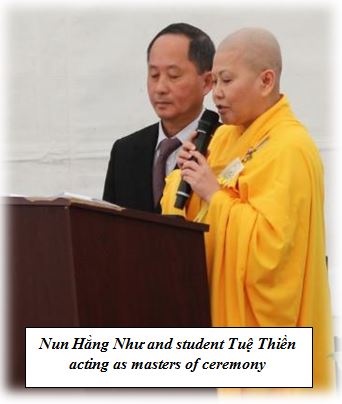
Exactly at 9am, the ceremony commenced with a simple Buddhist service. Everyone stood up with their hands clasped in front of their chest to recite three times the homage to Sakkhamuni Buddha.
First, the masters of ceremony introduced the guests. On behalf of the Most Venerable Thích Thông Triệt, Abbot of the Sunyata Meditation Monastery in Riverside, CA, they welcomed the guests of honor consisting of Venerable Thích Thông Giải, Deputy Head of the Đại Đăng meditation center in San Diego, CA; Bhikkhu Dhammo and the delegation from Toronto, Canada; and Venerable Nun Thích Nữ Minh Phước.
Representing the media was Mr Nguyên Giác Phan Tấn Hải, editor of the Việt Báo Kinh Tế magazine.
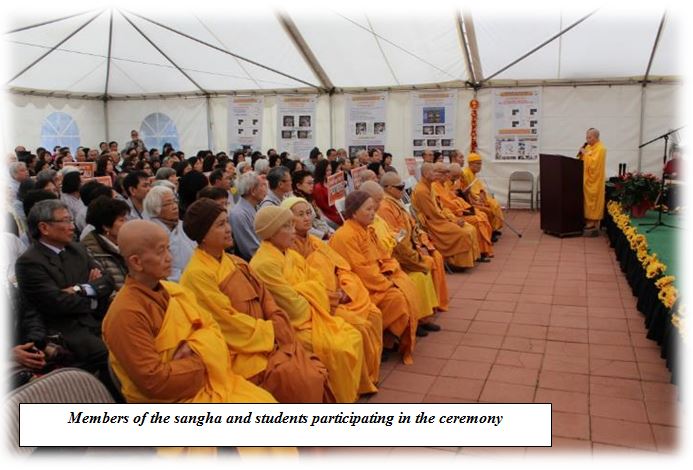
Members of the Sunyata Meditation sangha present included Venerables Thích Tuệ Chân and Thích Không Chiếu, the Most Virtuous Thích Không Như, Bhikkhuni Thích Nữ Phúc Trí, Bhikkhuni Zen Master Thích Nữ Triệt Như, Bhikkhunis Thích Nữ Hạnh Như and Thích Nữ Ý Như and novice nuns Thích Nữ Hằng Như, Thích Nữ Thường Như, Thích Nữ Phổ Như và Thích Nữ Lạc Như.
Sunyata Meditation practice communities around the world having representatives attending the ceremony included Southern California, USA (established in 1997), San Jose, California, USA (est. 2000), Houston, Texas, USA (est. 2001), Germany (est. 2001), Paris, France (est. 2002), Sydney, Australia (est. 2004), Toronto, Canada (est. 2004), Sacramento, California, USA (est. 2008), Toulouse, France (est. 2008), Switzerland (est. 2010), Poitiers, France (est. 2011), Washington D.C., USA (est. 2011).
Opening address by the President of the Sunyata Meditation Association, Southern California chapter
After several rounds of warm applause to greet various sections of the audience, the audience fell into silence when master of ceremony Thích Nữ Hằng Như invited a young meditation student to the podium to deliver the welcoming address in his capacity as President of the Sunyata Meditation Association, Southern California chapter.
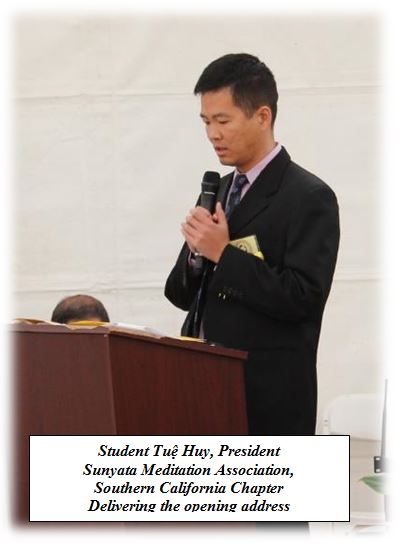
The address, delivered in an inspiring voice, was a sincere tribute from a student to the Master who has dedicated his life’s energy to teaching the dhamma over the last decades. Excerpts from the address are:
“Most Venerable Thích Thông Triệt; Venerables and honored Bhikkhu and Bhikkhuni; honored guests; my dear fellow meditation students;
Today, in the joyful celebratory spirit of the New Year, we are privileged to welcome you, most virtuous monks and nuns and honored guests, who have braved long travel distances to come here, at the Sunyata Meditation Monastery at Riverside, California to participate in this ceremony commemorating 20 years of disseminating the dhamma by the Sunyata Meditation School and the entrusting of the cloth ceremony.
Today is an important day for Sunyata Meditation students. The purpose of today is to first reflect on the highs, lows and achievements of twenty years disseminating the Buddhist dhamma by the Sunyata Meditation School. These achievements have been made possible by the sacrifice, perseverance, steadfastness and dedication towards the dissemination of the dhamma by Most Venerable Thích Thông Triệt, the founder of our Sunyata Meditation School.
The most notable achievement is the body of results that came from the collaborative research project between the University of Tuebingen in Germany and the Sunyata Meditation Association between 2007 and 2013. This historic achievement carries a very practical meaning to all those who are determined to practice in accordance with the teaching of Lord Buddha. It helps us understand clearly the processes of the mind through clear evidence established by contemporary scientific methods.
This great achievement of the Master has made the spiritual practice of students much clearer and more concrete. It also validates the wonderful realization of Zen Master Thường Chiếu who said nearly 1000 years ago: “When we know clearly the processes of the mind, our practice will become much easier”. This achievement establishes the Sunyata Meditation School as a practice method with four characteristics: practical, gradual, systemic and scientific.
Today is an opportunity for students from practice communities around the world to gather here at our Master Monastery at Riverside and offer our deep gratitude for the teaching that we have received from our Zen Master. The vow and sacrifice of Master Thích Thông Triệt is a shining evidence of the transformational effect of the Three Jewels. We have transmuted our suffering and left behind old erroneous perspectives, and are travelling assiduously on the spiritual path.
How do we manifest our gratitude in tangible ways?
We will always remember the nourishing teaching of our Master. The most tangible way to express our gratitude towards the Master is to practice the dhamma with good results.
With this infinite gratitude, I would like to formally open today’s great ceremony. Homage to our teacher Sakkhamuni Buddha.”
Opening Address by Zen Master Thích Thông Triệt
The following item was the opening speech by Zen Master Thích Thông Triệt. The speech consisted of only four short points. It nevertheless showed the character of a spiritual practitioner who has lived and nourished his spiritual mission in the most difficult and harsh conditions… through a strong and resolute determination.
“Homage to our teacher Sakkhamuni Buddha.
Dear guests
Today, in the solemn atmosphere of a fourth day of the New Year and in the presence of Venerable Thích Thông Giải and Bhikkhu Dhammo, I am honored to welcome you, most virtuous monks and nuns, honored guests and meditation students from around the world.
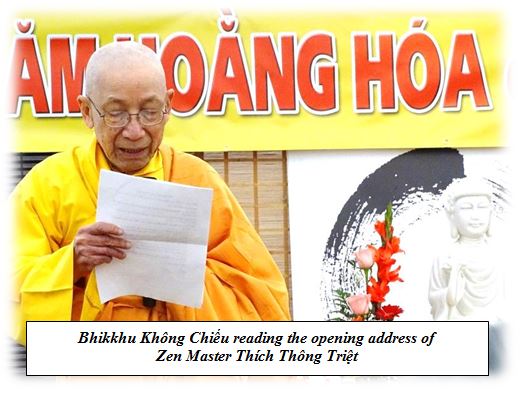
This is the first time in my time disseminating the dhamma that I have had to type an address for it to be read to you. I would like to present four points:
Point number one: since the day in 1982 when I realized the “No Talk” method in the Thanh Liệt prison camp in North Vietnam (which was also a fourth day of the New Year), I had the aspiration that, once I was freed, I would promulgate the teaching of the Buddha by reconciling it with modern neuroscience.
Point number two: in 1987, at the Chí Hoà prison, in South Vietnam, a question arose in my mind as to whether Theravāda Buddhism (also called the Smaller Vehicle) and Developmental Buddhism (also called the Great Vehicle) represent the true teaching of the Buddha. Since that time, I wished that I could have the opportunity to understand clearly the true teaching of the Buddha by studying the Pāli and Sanskrit texts.
Point number three: and then suddenly, my prison karma ended and in February 1989, I had my freedom back. At the end of 1992, I was able to resettle in the USA as a refugee. My two wishes became reality in the USA. In the last twenty years, I have been able to shine a scientific light onto the Buddhist meditation teaching and thus bring out the essence of the four main schools of Buddhism: Early Buddhism, Theravāda Buddhism, Developmental Buddhism and Zen Buddhism. I have studied the Pāli and Sanskrit texts as well as the history of Zen Buddhism to ascertain my role in the dissemination of the dhamma in the context of the 21st century in ways that are consistent with the Buddha’s true wishes.
Point number four: after 20 years disseminating the dhamma, I feel that I have reached old age, and my last wish is to entrust this mission into the capable hands of the next generation, so that I can concentrate on systematizing the curriculum of the seminars and writing new books that could be used as study materials for meditation students.
Dear guests,
My activities in the last 20 years, and my future plans will be presented in the next summary report. I wish all of you peace and harmony in your body and mind, and I thank you for your attention.
Homage to our teacher Sakkhamuni Buddha.”
Summary recapitulation of the activities of the SuNyata Meditation School in the last twenty years
The main theme of the ceremony was to recapitulate the journey of disseminating the Buddhist dhamma by our Master from 1995 to 2015. In these 20 years, our Master has achieved a great deal in his vow to serve others. Bhikkhuni Zen Master Thích Nữ Triệt Như was travelling with our Master on his teaching trips everywhere and has a good knowledge of our Master’s activities. Bhikkhuni had written a summary which she read to the audience:
“Homage to our teacher Sakkhamuni Buddha.
Dear Master, most virtuous monks and nuns, dear friends and meditation students
Today we commemorate 20 years of disseminating the Buddhist dhamma by our Zen Master in this joyful time of spring and blossoming cherry flowers. First, we students would like to wish our Master longevity and that our Master will keep good health so that he can accomplish his vow of serving others.
Dear guests, I will now read a short summary of the activities of the Sunyata Meditation School in the last 20 years.
Our Zen Master started his first meditation seminar on January 4, 1995 following the formal approval of his Beaverton, Oregon meditation hall by Elderly Bhikkhu Thích Thanh Từ when his Most Venerable visited the USA in 1994. From this time, our Zen Master has accomplished the following:
I. BOOK PUBLISHING
- The “Explanation of Meditation with accompanied diagrams” series, consisting of three books:
- Explanation of Meditation with accompanying diagrams, Book 1, published in 1996 (out of print)
- Explanation of Meditation with accompanying diagrams, Book 2, published in 1997 (out of print)
- Book 3: Through the Gate of Emptiness, published in 1997 (out of print)
- Series “Understanding and Practicing Buddhist Meditation”, consisting of three books:
- Part 1: The process of Spiritual Cultivation and Realization of the Buddha: first published in 1999, 2000 copies produced, out of print; second and revised edition published in July 2007, 4000 copies produced.
- Part 2: Effect of Meditation on People’s Lives: Book 1 (published in 2000, 2000 copies produced, out of print); Book 2 (published in 2005, 2000 copies produced, out of print)
- Part 3: Meditation Commentaries in Question and Answer Format (published in July 2007, 4000 copies produced)
- Book “Zen in the Light of Science”: published in August 2010 in Vietnamese and English. This book was written by our Zen Master and included articles from Dr Michael Erb and Dr Ranganatha Sitaram. These two scientists from the University of Tuebingen in Germany have conducted experiments using fMRI equipment, from 2007 to 2013, to assess the effect of the different stages of samādhi on different brain areas. The results show that, in the state of deep samādhi:
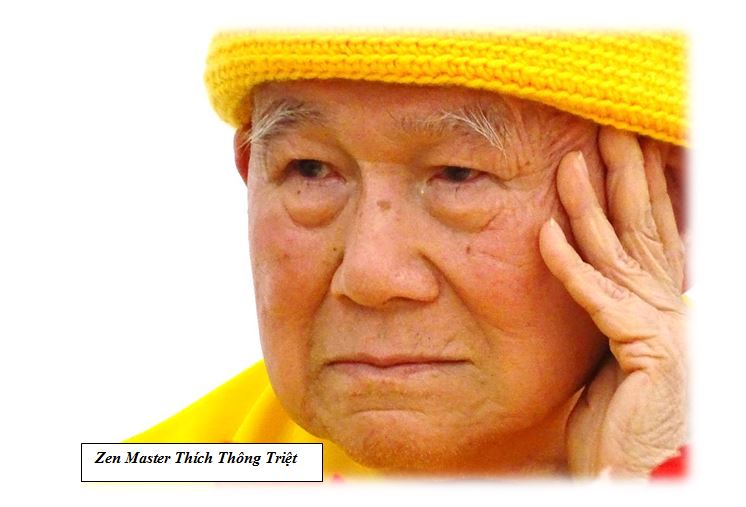
- All four elements of the wordless awareness mind located in the rear left brain cortex area – ultimate seeing, ultimate hearing, ultimate touch and ultimate cognition – were activated.
- At the same time, the precuneus, which lies deep inside the cortex, was also activated. This is the area of spiritual wisdom.
- During that time, all the structures that enable the language function remained inactive: Wernicke’s area, Broca’s area, the inner talk area, the inner dialogue area, the hypothalamus, the thinking mind and the intellect.
- Furthermore, the four stages of samādhi of the Buddha were validated: samādhi with inner talk and without inner dialogue; samādhi without inner talk and inner dialogue; full and clear awareness samādhi; and immobility samādhi.
- Book “Commentaries on the Process of Spiritual Cultivation, Realization and Enlightenment of the Buddha in Question and Answer Format” (published in August 2014, 4000 copies produced)
- Book “Commentaries on Zen Buddhism and Modern Knowledge in Question and Answer Format” (published in August 2014, 4000 copies produced).
II. DISSEMINATING THE BUDDHIST DHAMMA
In order to support the dissemination of the Buddhist dhamma, our Zen Master established eight Sunyata Meditation Associations in California (1999), Texas (2006), Paris (2007), Toulouse (2009), Stuttgart (2010), Lausanne (2011), Ontario (2012), and Sacramento (2014).
In addition, he established the following practice communities: in Oregon (1995), Southern California (1997), at the Sunyata Meditation Monastery (1999), in San Jose, California (2000), at the True Emptiness Meditation Hall (2010), in Houston, Texas (2001), at the Suchness Meditation Hall (2006), at the Sunyata Meditation Activity Center in Texas (January 4th, 2009), in Stuttgart, Germany (2002), Paris, France (2002), Sydney, Australia (2004), Toronto, Canada (2004), Sacramento, California (2008), Toulouse, France (2009), Lausanne, Switzerland (2010), Washington D.C., USA (2011), Poitiers, France (2011), Adelaide, Australia (2014), Montréal, Canada (2015).
List of activities:
Organized: 113 Fundamental Meditation seminars, 42 Intermediate Meditation “Paññā Wisdom” seminars, 19 Residential Samādhi and Paññā Meditation Practice seminars, 6 pilgrimage trips to India and Nepal which included samādhi practice seminars at Bodh Gaya, and annual retreats for members of the Sunyata Meditation sangha to practice samādhi meditation, study the clergy’s body of ethical rules, and abide by them.
In addition: there were also the Advanced Meditation “Buddhist Psychology” seminars; training seminars for lay teachers of the Fundamental Meditation course; bi-lingual seminars ranging from the Fundamental Meditation course to the Intermediate Meditation course for French, German, and Swiss audiences; public lectures to introduce Sunyata Meditation to the public; and Fundamental and Intermediate Qi-Gong Practice seminars to train the trainers in Qi-Gong practice.
The following is an outline of the first five-year plan for the period from 2015 to 2020
In order to further expand the dissemination of the Buddhist dhamma, in the service of the larger community, the Central Management Committee has set six priorities in the first five-year plan:
- Establish the Sunyata Foundation: the aim of the Foundation is to financially support the activities of the Sunyata Meditation Associations in their development efforts. The management committee of the Sunyata Foundation consists of: President: our Zen Master, Deputy: Bhikkhuni Thích Nữ Triệt Như, Secretary: meditation student Tuệ Chiếu; Treasurer: meditation student Tuệ Thông.
- Establish practice centers: Buddhist Meditation centers will be established at locations where causal conditions are present.
- Train lay teachers for the delivery of the Fundamental Meditation courses: the training program for lay teachers of the Fundamental Meditation course assigned to their practice communities will be completed.
- Develop the capability to webcast all seminars
- Systemize the curriculum of the Fundamental Meditation and Intermediate Meditation courses. The content of all courses will be systemized.
- Publish books and teaching videos. Develop and publish books for the Fundamental Meditation course, the Intermediate Meditation “Paññā Wisdom” course, and the Advanced Meditation “Buddhist Psychology” course, under the series “What Do I Know About…”.
Develop and publish the list of Buddhist terms commonly used in Buddhist meditation texts, in the form of an encyclopedic dictionary.
Publish teaching videos for the Fundamental Meditation course, the Intermediate Meditation “Paññā Wisdom” course, and the Advanced Meditation “Buddhist Psychology” course.
Re-print those books that are out of print.
“Dear guests
In order to achieve these objectives, we need to work together to promulgate Buddhist Meditation to the world, each of us offering our skills and dedication to this noble cause. I earnestly hope that all of you who are here today, in this Monastery, and all of you students who have benefited from spiritual practice, will work together in the spirit of unity and harmony to continue the work of our Zen Master, first to express our gratitude towards the Buddha and past patriarchs, and second to express our gratitude to our Zen Master who has spent the last 20 years teaching and nurturing us. And finally to express our gratitude to this life which has carried us.
In closing, I wish all of you harmony in your mind and body, and long lasting serenity.
Homage to our teacher Sakkhamuni Buddha.”
AWARDS TO PRACTICE COMMUNITIES
In order to encourage the spirit of service as well as to acknowledge the progress of students in their spiritual practice, Zen Master Thích Thông Triệt issued congratulatory certificates to the 12 practice communities who had representatives attending the commemoration ceremony and the training seminars that the Zen Master would conduct after the ceremony. The content of the congratulatory certificates varied in accordance with the activities of each practice community. Some practice communities have organized their study program very well, others have excelled at performing arts productions, others have demonstrated the spirit of unity, harmony and cooperation etc. The awards were read out by Venerable Thích Tuệ Chân under the certification of Zen Master Thích Thông Triệt.
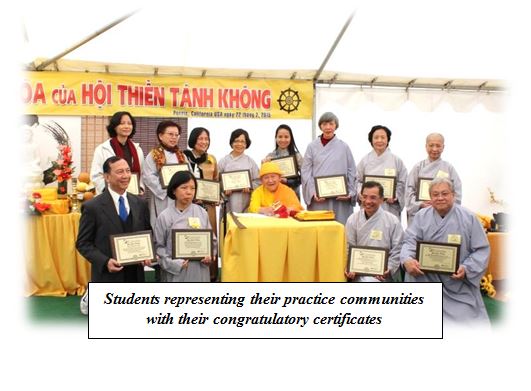
Promulgation of the revised Pure Constitution
During the ceremony commemorating 20 years of disseminating the dhamma by the Sunyata Meditation School, Zen Master Thích Thông Triệt promulgated an amended version of the Pure Constitution. The amended Pure Constitution will be handed to the management committees of each practice community to use as a guide for the conduct of activities within the practice community. All activities need to be conducted in accordance with the Pure Constitution in order to maintain good processes and build a spirit of unity and harmony in the spiritual practice.
The Pure Constitution is the governance document of a Zen Meditation school, in the same way as a constitution applies to a nation. It is a living document that can be amended to respond to changing times and circumstances. The first edition of the Pure Constitution was promulgated by Zen Master Thích Thông Triệt in 1998. It had clauses governing the following:
- Purpose, aims and approaches of the Sunyata Meditation School.
- Organization, management and responsibilities of the Sunyata Meditation Associations and Sunyata Meditation practice communities.
- Ethics and conduct of meditation students: unity and harmony when interacting with each other.
The amended Pure Constitution has clauses defining the rules applicable to joining the sangha inside and outside the USA.
Information about the amended Pure Constitution of the Sunyata Meditation School was briefly read out by Bhikkhu Thích Không Chiếu during this ceremony, in the presence of over 200 meditation students representing 12 practice communities.
The ENTRUSTING of the cloth and meditation stick ceremony
There were two important items in today’s ceremony. The first item was the opportunity for all present to review the past 20 years and reflect on the highs, lows and achievements on the journey of disseminating the Buddhist dhamma by Zen Master Thích Thông Triệt. The second item was the entrusting of the responsibilities for disseminating the Buddhist dhamma to the second generation, in the person of Bhikkhuni Thích Nữ Triệt Như. The statement of succession was solemnly read in full by Venerable Thích Tuệ Chân as follows:
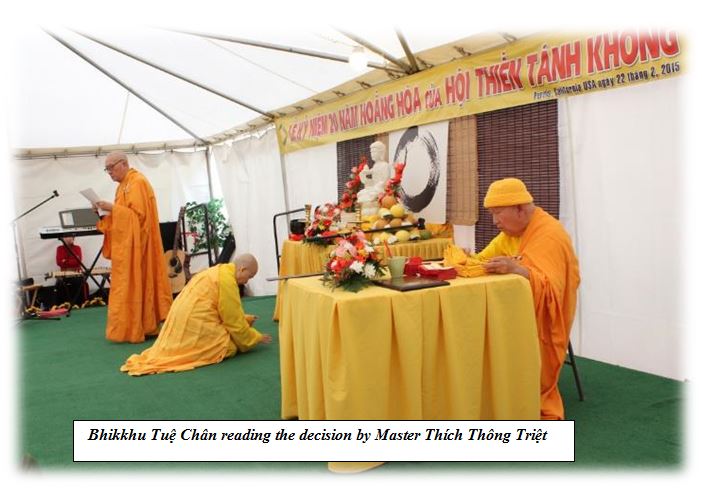
A. Decisions by Zen Master Thích Thông Triệt and their reasons
First reason: the leader of a public organization must understand the following three things:
- First, the leader must select a successor.
- Second, the leader must know his/her and his/her successor’s capabilities and capacity for work.
- Third, the leader must publicly communicate to the membership who has been selected as successor.
Second reason: I, your Master, am of the opinion that the successor must have a virtuous demeanor, must conduct him/herself in accordance with his/her position as a spiritual leader, must be able to teach the theory and practice in accordance with the true intent of the Buddha and past patriarchs, and must be able to reconcile the teaching with modern science in accordance with my own teaching direction.
My position is that the decision, once made, is irrevocable.
Third reason: I am now of advanced age, and selecting a successor is an obvious thing to do.
Decision:
For the reasons stated above, today I communicate to all meditation students in all practice communities that I have decided to choose Bhikkhuni Triệt Như as my successor.
Bhikkhuni Triệt Như has studied under me since the Fundamental Meditation course in 1996, and then on to the Paññā Wisdom courses, the Buddhist Psychology courses and the training courses for lay teachers. Bhikkhuni joined the sangha in 2004 at Bodh Gaya and received the full commands of the sangha in 2005.
Since joining the sangha, Bhikkhuni has followed me on my teaching trips to practice communities in the role of “assistant teacher” and is known for her ability to make summary diagrams that encapsulate my teaching.
Since the beginning of 2007, I have given Bhikkhuni permission to conduct the Fundamental Meditation courses in practice communities everywhere. Following that, Bhikkhuni was authorized to teach the Intermediate Meditation courses Level 1, 2 and 3. She is well versed in all four knowledge areas of Buddhism, Zen Buddhism, science and meditation practice techniques. Therefore, she deserves to be the person that replaces me in the tasks of disseminating the Buddhist dhamma and leading the practice communities.
From today, Bhikkhuni is required to follow the Pure Constitution in leading the practice communities using her verbal and wordless cognition capacity.
I now entrust the ceremonial cloth and ceremonial meditation stick to Bhikkhuni Triệt Như, the successor of our school. The ceremonial cloth represents the Buddha’s teaching. The ceremonial meditation stick is the symbol of the teaching of the Zen patriarchs. Today, I ENTRUST the teaching to you. Use it to guide your actions.
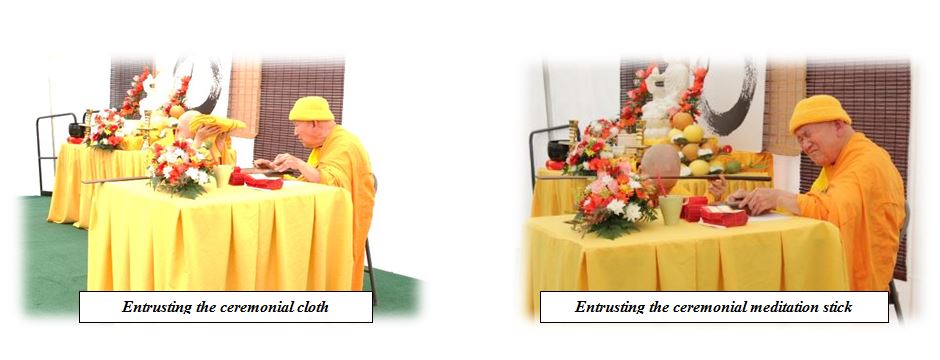
Address by Bhikkhuni TRIỆT NHƯ
“Homage to our teacher Sakkhamuni Buddha,
My Master,
I, your student Thích Nữ Triệt Như, today receive your ceremonial cloth and ceremonial meditation stick as your successor for our school. This is a great responsibility which is difficult to fulfill. I think that my abilities are still young and weak as I am just a novice student who has just taken tentative steps on the meditation path and has not accumulated much experience. I know that I am yet to be worthy of your high expectations.
However, you have given your instruction, therefore, as your student, I will bow my head and say “I will execute as per your instruction”. I accept the ceremonial cloth and ceremonial meditation stick as symbols of our school, with the wish that, in only a short period of time, I will be able to entrust them onto the younger generation. I pray that all Buddhas and Bodhisattvas will assist me in their compassion and certify my true wish.
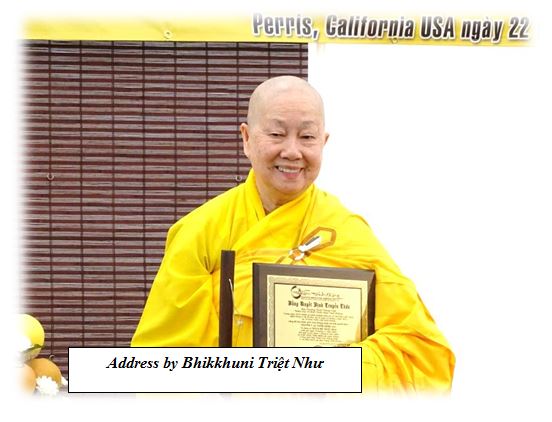
The succession ceremony was simple but did not lack solemnity or inspiration – from the choked and halting voice of the student when receiving the ceremonial cloth and ceremonial meditation stick, to the tears of sympathy from the Master who knew the burden of the responsibilities now entrusted onto the student. The moving atmosphere soon became contagious, and many students in the audience shed tears. Right at that moment, nun Hằng Như quickly changed the pensive mood into a joyful one. She guided the audience to a standing ovation to welcome the new representative of the Sunyata Meditation School, who will act on behalf of Zen Master Thích Thông Triệt in the task of disseminating the Buddhist dhamma and guiding future students.
“Dear Master, dear most virtuous monks and nuns. The succession ceremony for our school has taken place in a simple but inspiring manner. From this moment on, Bhikkhuni Thích Nữ Triệt Như will shoulder the heavy responsibility in lieu of our Master, to steer the Sunyata Meditation boat towards the high seas, with all the difficulty involved in helping us, younger siblings, who are already sitting on the boat, and getting more people on board, to take all to the other shore, using the teaching and practice first enunciated by the Buddha and which our Zen Master has guided us through in the last 20 years. To welcome our leader, let us applaud and vow to support Bhikkhuni Triệt Như to confidently steer the Sunyata Meditation boat to sea, continuing the work of our Zen Master in disseminating the dhamma.
Everyone stood up and applauded, clearing away the pensive and solemn atmosphere. On the stage, Master had a benign smile and Bhikkhuni Triệt Như, holding in one hand the ceremonial cloth and in the other the ceremonial meditation stick, had a radiant smile, acknowledging the support and love that all students in the audience had for her.
The following item on the program was a traditional poem chanting number.
![]()


